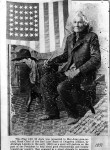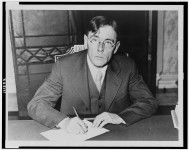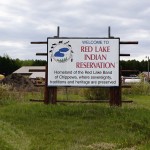Although treaties recognized Indian tribes as self-governing nations, the U.S. government exercised extensive power over reservations. Change came in 1934 when Congress passed the Indian Reorganization Act (IRA), which encouraged Native people to reorganize tribal governments and manage reservation affairs. Demands for greater tribal self-rule swept Indian Country in the mid- to late-20th century, fueling the reassertion of Native sovereignty.
“We have every right . . . to run our own affairs. You should be able to do what you want to do in your own community, your own yard.“
— Roger Jourdain, a strong advocate for Native American self-determination, served as tribal chairman of the Red Lake Band of Chippewa from 1959–1990

Chief May-dwa-gwa-no-nin | Courtesy of the Red Lake Nation Archives and Library
Indian Reorganization Act
Following his appointment as U.S. Commissioner of Indian Affairs in 1933, John Collier inaugurated the Indian Reorganization Act, or “Indian New Deal,” which shifted Indian policy toward enhancing tribal self-government.
Impact of the “Indian New Deal”
- Ojibwe tribes vote to accept the IRA and form modern, constitution-based governments
- Minnesota Chippewa Tribe was created, representing all Ojibwe tribal governments except for Red Lake
- United States recognizes historical Dakota ties to Minnesota through establishment of reservations
- Tribal governments established on Upper and Lower Sioux reservations
- Dakota at Prairie Island organize tribal government

John Collier | Courtesy of the Library of Congress, Prints and Photographs Division
Traditional Governance
Some Native nations in Minnesota retain aspects of traditional tribal leadership. At Red Lake, hereditary tribal chiefs sit at all tribal council meetings. White Earth Ojibwe revised their tribal constitution in 2009 to incorporate their traditional ideals and values.

One of seven hereditary chiefs of the Red Lake Band of Chippewa Indians, George “Billy” King is a descendant of Chief May-dwa-gwa-no-nin who opposed the allotment of Red Lake tribal lands in 1889. | Courtesy of the Red Lake Nation Archives and Library

Roger Jourdain, a strong advocate for Native American self-determination, served as tribal chairman of the Red Lake Band of Chippewa from 1959–1990. | Courtesy of the Star Tribune / Minneapolis–St. Paul 2011
Self-Determination
During the 1960s and ’70s, Native American demands for greater tribal control over reservation life swept Indian Country. Tribal governments increasingly asserted their power and sovereign authority over their own people. Today, the United States recognizes tribal rights to manage programs formerly administered by the federal government, and officially endorses nation-to-nation relations with tribal governments.

“Welcome to Red Lake Indian Reservation” sign | Photo by Michael Barrett, courtesy of the Red Lake Nation












